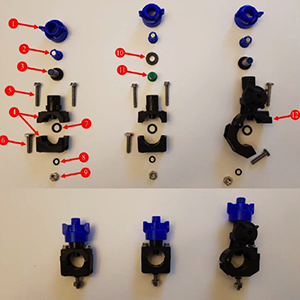Aeroponic systems design: considerations and challenges

Published:15 September 2022
Abstract Views: 4908
PDF: 1677
Appendix: 128
HTML: 2968
Appendix: 128
HTML: 2968
Publisher's note
All claims expressed in this article are solely those of the authors and do not necessarily represent those of their affiliated organizations, or those of the publisher, the editors and the reviewers. Any product that may be evaluated in this article or claim that may be made by its manufacturer is not guaranteed or endorsed by the publisher.
All claims expressed in this article are solely those of the authors and do not necessarily represent those of their affiliated organizations, or those of the publisher, the editors and the reviewers. Any product that may be evaluated in this article or claim that may be made by its manufacturer is not guaranteed or endorsed by the publisher.
Similar Articles
- Alessandro D'Emilio, Simona M.C. Porto, Giovanni Cascone, Marco Bella, Marco Gulino, Mitigating heat stress of dairy cows bred in a free-stall barn by sprinkler systems coupled with forced ventilation , Journal of Agricultural Engineering: Vol. 48 No. 4 (2017)
- Francesca Valenti, Simona M.C. Porto, Giovanni Cascone, Claudia Arcidiacono, Potential biogas production from agricultural by-products in Sicily. A case study of citrus pulp and olive pomace , Journal of Agricultural Engineering: Vol. 48 No. 4 (2017)
- Marzia Quattrone, Giovanna Tomaselli, Lara Riguccio, Patrizia Russo, Assessment of the territorial suitability for the creation of the greenways networks: Methodological application in the Sicilian landscape context , Journal of Agricultural Engineering: Vol. 48 No. 4 (2017)
- Lara Riguccio, Laura Carullo, Patrizia Russo, Giovanna Tomaselli, A landscape project for the coexistence of agriculture and nature: a proposal for the coastal area of a Natura 2000 site in Sicily (Italy) , Journal of Agricultural Engineering: Vol. 47 No. 2 (2016)
- Wei Deng, Chunjiang Zhao, Liping Chen, Xiu Wang, Constant pressure control for variable-rate spray using closed-loop proportion integration differentiation regulation , Journal of Agricultural Engineering: Vol. 47 No. 3 (2016)
- Andrea Peruzzi, Luisa Martelloni, Christian Frasconi, Marco Fontanelli, Michel Pirchio, Michele Raffaelli, Machines for non-chemical intra-row weed control in narrow and wide-row crops: a review , Journal of Agricultural Engineering: Vol. 48 No. 2 (2017)
- Francesco Barreca, Giuseppe Modica, Salvatore Di Fazio, Viviana Tirella, Raimondo Tripodi, Carmelo Riccardo Fichera, Improving building energy modelling by applying advanced 3D surveying techniques on agri-food facilities , Journal of Agricultural Engineering: Vol. 48 No. 4 (2017)
- Lara Riguccio, Giovanna Tomaselli, Laura Carullo, Danilo Verde, Patrizia Russo, Identifying areas suitable for wine tourism through the use of multi-criteria and geographic information system: the method and its application in the countryside around Mount Etna (Sicily) , Journal of Agricultural Engineering: Vol. 48 No. 2 (2017)
- Zhongkuan Wang, Sheng Wen, Yubin Lan, Yue Liu, Yingying Dong, Variable-rate spray system for unmanned aerial applications using lag compensation algorithm and pulse width modulation spray technology , Journal of Agricultural Engineering: Vol. 55 No. 1 (2024)
- Celeste Righi Ricco, Alberto Finzi, Viviana Guido, Elisabetta Riva, Omar Ferrari, Giorgio Provolo , Evaluation of ammonia emissions from filtration of digestate used for fertigation , Journal of Agricultural Engineering: Vol. 52 No. 3 (2021)
You may also start an advanced similarity search for this article.

 https://doi.org/10.4081/jae.2022.1387
https://doi.org/10.4081/jae.2022.1387 






